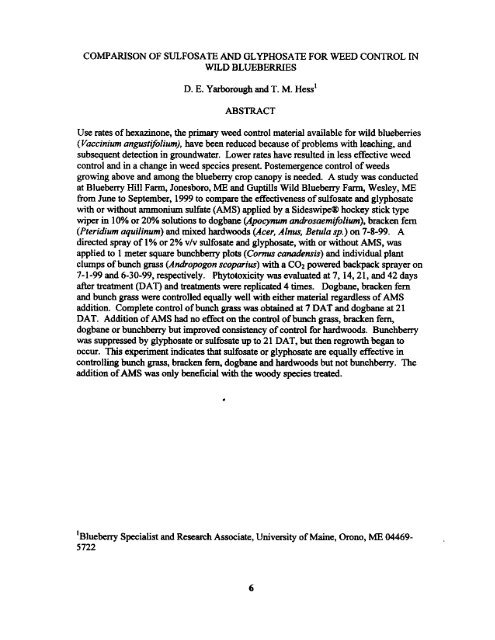Vol. 54â2000 - NorthEastern Weed Science Society
Vol. 54â2000 - NorthEastern Weed Science Society Vol. 54â2000 - NorthEastern Weed Science Society
COMPARISON OF SULFOSATE AND GLYPHOSA TE FOR WEED CONTROL IN WILD BLUEBERRIES D. E. Yarborough and T. M. Hess' ABSTRACT Use ratesofhexazinone, theprimaryweedcontrolmaterialavailableforwild blueberries (Vaccinium angustifolium), havebeenreducedbecauseof problemswithleaching.and subsequentdetectionin groundwater.Lowerrateshaveresultedin less effective weed controlandin a changein weed speciespresent.Postemergencecontrolof weeds growingaboveandamongtheblueberrycropcanopyis needed. A studywas conducted at Blueberry Hill Farm, Jonesboro, ME and Guptills Wild Blueberry Farm, Wesley, ME from June to September, 1999 to compare the effectiveness of sulfosate and glyphosate with or without ammonium sulfate (AMS) applied by a Sideswipe® hockey stick type wiper in 10% or 20% solutions to dogbane (Apocynum androsaemifolium), bracken fern (Pteridium aqui/inum) and mixed hardwoods (Acer, Alnus, Betula sp.) on 7-8-99. A directed spray of I% or 2% v/v sulfosate and glyphosate, with or without AMS, was applied to I meter square bunchberry plots (Comus canadensis) and individual plant clumps of bunch grass (Andropogon scoparius) with a CO, powered backpack sprayer on 7-1-99 and 6-30-99, respectively. Phytotoxicity was evaluated at 7,14,21, and 42 days aftertreatment(DAl) andtreatmentswere replicated4 times. Dogbane,brackenfern and bunch grass were controlled equally well with either material regardless of AMS addition. Complete control of bunch grass was obtained at 7 DAT and dogbane at 21 DAT. Addition of AMS hadno effect on the control of bunch grass, bracken fern, dogbane or bunchberry but improved consistency of control for hardwoods. Bunchberry was suppressed by glyphosate or sulfosate up to 21 DAT, hut then regrowth began to occur. Thisexperimentindicatesthatsulfosateorglyphosateareequallyeffective in controlling bunch grass, bracken fern, doghane and hardwoods but not hunchberry. The addition of AMS was only beneficial with the woody species treated. • 'Blueberry Specialist and Research Associate, University of Maine, Orono, ME 04469 5722 6
Comparisonof Sulfosateand Glyphosatewith AMS for HardwoodControl 120 phytotoxicity 80 60 40 20 f--------------------j 01------ ____ 7 OAT 14 OAT 21 OAT 42 OAT r-----~=._---___, Comparisonof Sulfosateand Glyphosate withoutAMS for HardwoodControl 120 phytotoxicity 100 -- -- -- --:====="/~-I 60 ~--~---------- 40 20 O.... ---- ~ 7 OAT 14 OAT 21 DAT 42 OAT .-------~=,.,,--------, Treatment ~10%GLY .. 10%SlA. +20%GLY +20%SlA. -lITe Material=-significant at 7 OAT and highly significant at 14 and 21 OAT, Rate=highly significant at 7 OAT,and 21 OAT 7
- Page 1 and 2: WEED REMOVAL TIMING WITH ROUNDUP RE
- Page 3 and 4: EFFECT OF HERBICIDE RATES AND IRRIG
- Page 5: 40 Effect of Pronone Applied with A
- Page 9 and 10: N 1175 feet Roundup Ready Studies R
- Page 11 and 12: VIRGINIA TECH'S ONLINE WEED IDENTIF
- Page 13 and 14: WEED CONTROL AND YIELD OF CUT FLOWE
- Page 15 and 16: Table I. Effect of napropamide and
- Page 17 and 18: The Effect of Total Postemergence H
- Page 19 and 20: with commercial fertilizer. In gene
- Page 21 and 22: HERBICIDE APPLICATIONS VERSUS HANDW
- Page 23 and 24: exceeded 4. The success of training
- Page 25 and 26: _u ____ Table2: Estimatesof herbace
- Page 27 and 28: DOUBLE CROP CORN WEED CONTROL IN VI
- Page 29 and 30: ANNUAL WEED AND GRASS CONTROL IN CO
- Page 31 and 32: MANAGING QUACKGRASSINFESTATIONSAS C
- Page 33 and 34: USING HERBICIDE RESISTANT HYBRIDS T
- Page 35 and 36: NICOSULFURONIRIMSULFURON COMBINATIO
- Page 37 and 38: GLYPHOSATE ALONE AND PRECEDED BY PR
- Page 39 and 40: ROUNDUPVS. LIBERTY:WHATHAVE WE LEAR
- Page 41 and 42: In summary, application timing for
- Page 43 and 44: INFLUENCE OF TIMING ON WEED MANAGEM
- Page 45 and 46: IMPACT OF GLYPHOSATE TIMING AND COR
- Page 47 and 48: PREEMERGENCE HERBICIDES INFLUENCE W
- Page 49 and 50: COMPARISON OF WEED CONTROL SYSTEMS
- Page 51 and 52: Table I Mean Percent Weed Control V
- Page 53 and 54: SMALL GRAIN WEED CONTROL - NEW WEED
- Page 55 and 56: MODE OF ACTION, ABSORPTION, TRANSLO
COMPARISON<br />
OF SULFOSATE AND GLYPHOSA TE FOR WEED CONTROL IN<br />
WILD BLUEBERRIES<br />
D. E. Yarborough and T. M. Hess'<br />
ABSTRACT<br />
Use ratesofhexazinone, theprimaryweedcontrolmaterialavailableforwild blueberries<br />
(Vaccinium angustifolium), havebeenreducedbecauseof problemswithleaching.and<br />
subsequentdetectionin groundwater.Lowerrateshaveresultedin less effective weed<br />
controlandin a changein weed speciespresent.Postemergencecontrolof weeds<br />
growingaboveandamongtheblueberrycropcanopyis needed. A studywas conducted<br />
at Blueberry Hill Farm, Jonesboro, ME and Guptills Wild Blueberry Farm, Wesley, ME<br />
from June to September, 1999 to compare the effectiveness of sulfosate and glyphosate<br />
with or without ammonium sulfate (AMS) applied by a Sideswipe® hockey stick type<br />
wiper in 10% or 20% solutions to dogbane (Apocynum androsaemifolium), bracken fern<br />
(Pteridium aqui/inum) and mixed hardwoods (Acer, Alnus, Betula sp.) on 7-8-99. A<br />
directed spray of I% or 2% v/v sulfosate and glyphosate, with or without AMS, was<br />
applied to I meter square bunchberry plots (Comus canadensis) and individual plant<br />
clumps of bunch grass (Andropogon scoparius) with a CO, powered backpack sprayer on<br />
7-1-99 and 6-30-99, respectively. Phytotoxicity was evaluated at 7,14,21, and 42 days<br />
aftertreatment(DAl) andtreatmentswere replicated4 times. Dogbane,brackenfern<br />
and bunch grass were controlled equally well with either material regardless of AMS<br />
addition. Complete control of bunch grass was obtained at 7 DAT and dogbane at 21<br />
DAT. Addition of AMS hadno effect on the control of bunch grass, bracken fern,<br />
dogbane or bunchberry but improved consistency of control for hardwoods. Bunchberry<br />
was suppressed by glyphosate or sulfosate up to 21 DAT, hut then regrowth began to<br />
occur. Thisexperimentindicatesthatsulfosateorglyphosateareequallyeffective in<br />
controlling bunch grass, bracken fern, doghane and hardwoods but not hunchberry. The<br />
addition of AMS was only beneficial with the woody species treated.<br />
•<br />
'Blueberry Specialist and Research Associate, University of Maine, Orono, ME 04469<br />
5722<br />
6



